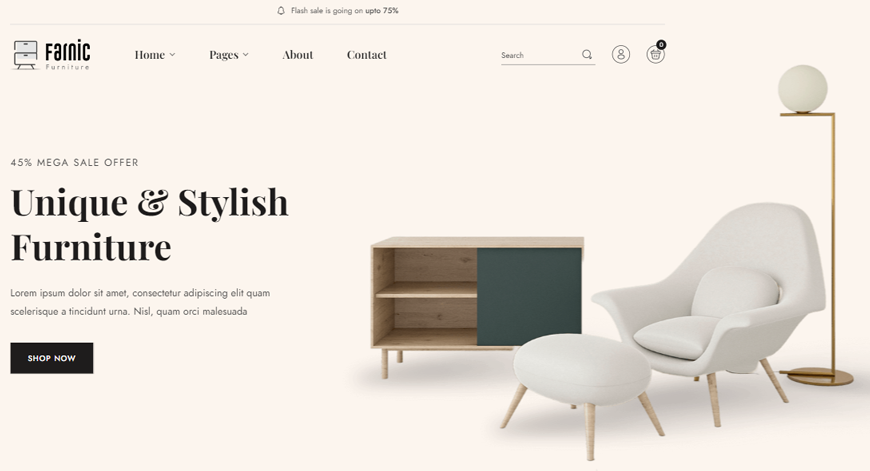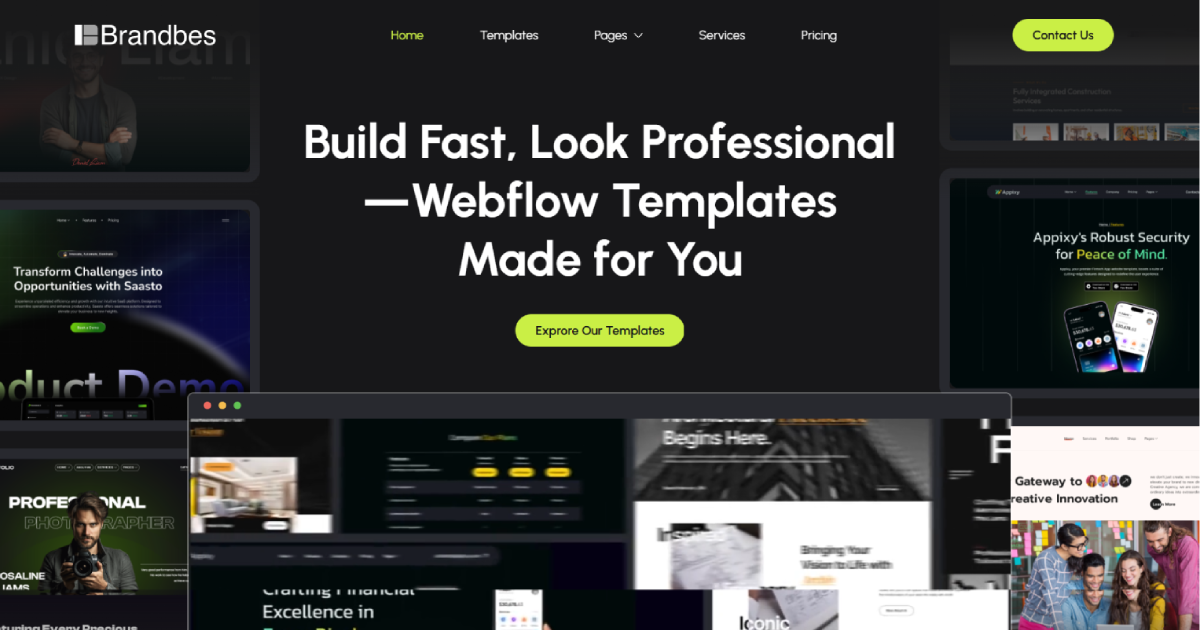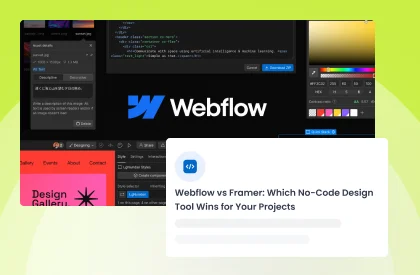Are you looking for an easy way to create and manage your online store? If so, then you may have heard of both Webflow and Shopify. Both are popular eCommerce platforms that offer features such as web design tools, payment processing solutions, customer support, and more. But, Webflow vs Shopify? Which one is better suited for your needs?
In this article, we’ll compare Webflow vs Shopify to give you a better understanding of each platform so that you can make the best decision for your business. In addition, we’ll discuss topics such as pricing plans, design options, user-friendliness, and more so that you can decide which one is right for your online store.
Importance of choosing the right platform for your online business
Choosing the right platform for your online business is crucial for several reasons. Here are some key factors to take into account when comparing Webflow vs Shopify:
Features and Functionality: Different platforms offer various levels of features and functionalities that can significantly impact your business operations. The right platform should align with your specific business needs and provide the necessary web design tools and eCommerce functionalities to support your operations, such as inventory management, order processing, payment gateways, and customer support.
Scalability and Growth Potential: As your online business grows, scalability becomes a critical factor. The chosen platform should have the capacity to handle increasing traffic, product catalog expansion, and growing customer base without compromising performance. It should offer scalability options, such as flexible hosting plans or the ability to integrate with third-party services, allowing your business to grow smoothly.
Customization and Branding: Your online business should have a unique brand identity that sets it apart from competitors. The platform you choose should provide customization options that allow you to create a visually appealing and branded website. This includes the ability to customize templates, colors, fonts, and layouts, ensuring your online store reflects your brand image effectively.
User Experience: A positive web design experience is crucial for customer satisfaction and conversion rates. This platform should offer intuitive navigation, mobile responsiveness, fast page loading times, and seamless checkout. These elements contribute to a smooth and enjoyable shopping experience, leading to higher customer retention and repeat purchases.
SEO and Marketing Capabilities: Online visibility is essential for attracting customers. The platform should have built-in SEO features or provide easy integration with SEO tools to optimize your website for search engines. Additionally, it should support various marketing channels, such as email marketing, social media integration, and content marketing, allowing you to promote your business effectively.
100+ Top-notch Webflow Templates
Take your website design to the next level with our stunning collection of Webflow templates.
Webflow: Overview

Webflow is a game-changer for anyone who wants to create a website without needing to be a coding expert. Thanks to its unique design principles that merge drag-and-drop functionality with responsive elements, this web-based platform provides unprecedented control and flexibility.
What’s more, it offers a range of hosting options, and its capabilities extend beyond website-building to include virtual commerce platform and CMS features.
So, whether you’re looking for an alternative to WordPress or simply a more streamlined way to create your website, Webflow is definitely worth considering. With so many customizations available, you’ll be able to create the exact website you envision with ease.
Shopify: Overview
Shopify is the solution for anyone who wants to launch an eCommerce business with ease. Founded in 2004 by satisfied snowboarding enthusiasts, the platform is the longest-running provider in the industry.
Set up your web store without the headache of a complicated website. Shopify’s goal is to make it simple for you to get started, so you can concentrate on growing your business.
With a focus on accessibility and simplicity, Shopify ensures that all of your needs are met so you can focus on the bigger picture. Turn your idea into a reality with Shopify, the online commerce platform designed for ease.
Comparison of Key Factors
Here’s a comparison of key factors between Webflow vs Shopify:
Website Builder and Customization Features
Webflow
Designing a website can be daunting if you aren’t familiar with coding. But with Webflow eCommerce builder, you have the power to make a stunning website that is entirely your own. The drag-and-drop editor lets you move elements around with ease, and you can customize them to your heart’s content.
Add animations, create hover effects, and add parallax scrolling to take the user on a journey. And with progress bars, you can let them know where they are on that journey. Your website will stand out with its bespoke design, and you’ll have created it all with just a few clicks.
Shopify
While Shopify eCommerce builder may have some limitations in terms of customization, there’s no need to worry. With an extensive collection of free and premium Shopify templates, creating an attractive and functional website is a breeze. However, if you want to give your web store site a truly unique look, you may need to work with a developer to modify the Shopify templates. Liquid templating code may seem intimidating, but don’t let it discourage you! With a little help, you can create a customized site that best reflects your brand.
eCommerce Features
Webflow
Although Webflow editor includes eCommerce capabilities, it is not as feature-rich as Shopify. You can make product listings, control inventory, and complete orders with it. However, It might be lacking in some cutting-edge capabilities that are crucial for bigger or more intricate eCommerce firms.
Shopify
Shopify offers a wide range of capabilities and was created especially for eCommerce. Orders, payments, and product listings are all simple to administer. It interacts with different delivery providers, supports a number of payment gateways, and offers abandoned cart recovery.
Inventory Management
Shopify
Managing inventory can be a daunting task, especially for eCommerce entrepreneurs. Two platforms that offer different approaches to inventory management are Shopify and Webflow. Shopify’s system is the complete package when it comes to managing orders. Its user-friendly dashboard allows you to easily track orders, process payments, generate shipping labels, and handle returns or exchanges. Shopify also integrates with various shipping carriers and Shopify payment gateways, making your life a lot easier.
Webflow
On the other hand, Webflow editor does not offer advanced order management features and does not natively integrate with shipping carriers or payment gateways. Therefore, when it comes to managing your online store’s inventory, it’s essential to consider and compare the different options available.
Shopping and Taxes
Webflow
Webflow lacks native tax administration and calculating functionality. As a result, you would need to handle tax calculations and collection manually or make use of third-party integrations since it does not automatically calculate taxes. This can be a drawback if you have particular tax compliance requirements or work in an area with complicated tax laws.
Shopify
Shopify provides integrated tax administration and calculating capabilities. Based on the store’s location and the customer’s shipping address, taxes are automatically calculated. To manage more complex tax requirements, such as managing tax nexus, collecting sales tax, and generating tax reports, Shopify also integrates with a number of tax tools and services.
Marketing Features
Webflow
Webflow makes up for its lack of integrated digital marketing capabilities by providing strong technical tools for SEO optimization. Users have easy access to the platform to edit technical SEO elements like meta descriptions and page titles. Although Webflow doesn’t offer native marketing solutions, a large range of third-party integrations are offered to support marketing initiatives.
Shopify
Over the years, Shopify has consistently improved its skills in digital marketing. A number of potent features are available, including the capacity to make Facebook advertising directly from the portal. Users may effortlessly manage email marketing campaigns from the main dashboard as well. Businesses can more easily promote their products and reach their target audience thanks to these connected technologies that ease marketing efforts.
Pricing
Webflow
Webflow website builders offer two different sorts of plans.
- Site plans
- eCommerce plans
The site plans are as follows:

- FREE
- Basic – $18/mo (billed monthly) and $14 /mo (billed yearly)
- CMS – $29/mo (billed monthly) and $23 /mo (billed yearly)
- Business- $49/mo (billed monthly) and $39 /mo (billed yearly)
- Enterprise- Contact web flow
The eCommerce plans are as follows:

- Standard – $42/mo (billed monthly) and $29 /mo (billed yearly)
- Plus – $84/mo (billed monthly) and $74 /mo (billed yearly)
- Advanced – $235/mo (billed monthly) and $212/mo (billed yearly)
Shopify
Shopify offers two different sorts of plans.
- Monthly plans
- Yearly plans
Monthly plans
- Basic Shopify Plan – $25 per month
- Shopify Plan – $65 per month
- Advanced Shopify Plan – $399 per month
Yearly plans
- Basic Shopify Plan – $19 per month
- Shopify Plan – $49 per month
- Advanced Shopify Plan – $299 per month
Top Recommended Post for You:
👉 A Comprehensive Comparison of Webflow vs Elementor
👉 Editor X vs Webflow: A Complete Review
👉 Webflow vs Unbounce: Which Is the Best Landing Page Builder for You?
👉 Webflow Vs Showit: Which Website Builder is Best For You?
👉 Webflow vs Readymag: Which Is Best for Your Needs?
Frequently Asked Questions
Can Webflow be used to create eCommerce websites?
While Webflow has some eCommerce functionality, it is primarily a website design and development platform and may not have all of the features necessary to create a robust eCommerce website.
Which platform is easier to use, Webflow or Shopify?
Both Webflow and Shopify have user-friendly interfaces and are designed to be easy to use. However, Webflow editor may have a steeper learning curve for those who are unfamiliar with web design and development.
Can Webflow and Shopify be integrated?
Yes, Webflow and Shopify can be integrated so that businesses can use both platforms together to create a seamless user experience.
Which platform is better for creating custom designs, Webflow or Shopify?
Webflow is designed specifically for creating custom website designs, while Shopify has more limitations in terms of design customization.
Does Webflow or Shopify offer better security features?
Both platforms offer secure hosting and SSL certificates, but Shopify may have more robust security features due to its focus on eCommerce and managing sensitive customer information.
Which platform is more affordable, Webflow or Shopify?
The cost of using Webflow or Shopify depends on the specific plan and features selected. Webflow offers a range of pricing plans, while Shopify has a set monthly fee plus transaction fees for each sale made through the platform.
100+ Top-notch Webflow Templates
Take your website design to the next level with our stunning collection of Webflow templates.
Bonus: Suggested Webflow Templates for eCommerce Store
Qlonil – Retail Website Template
For modern business owners seeking an easily customizable eCommerce platform, the Qlonil – Webflow eCommerce Template is a fantastic option. This template offers all the necessary features, pages, and collections to simplify the process of launching an online retail store. The Qlonil template includes several static pages, including three homepage options, a shop page, and a blog page.

Additionally, it provides a CMS collection that includes an author page, blog categories, tags, team members, and blog post pages. One of the most convenient aspects of this eCommerce website template is its responsive design, which makes it easy to view on all devices, including desktops, mobile phones, and tablets.
If you’re looking for an accessible and straightforward eCommerce website template, the Qlonil – Webflow eCommerce Template is an excellent choice.
Highlighted Features:
- Customizable look:
- eCommerce capabilities
- SEO Friendliness
- Responsive Layout
- Blogging capabilities
Price: Regular License: $79
Farnic – Furniture Website Template
Are you feeling daunted by the task of setting up an online store? Not to worry – you can breathe easy knowing that Farnic – Furniture Website Template has got you covered! This hassle-free solution delivers a website that combines beautiful web design with optimized functionality – and is responsive to boot!

By leveraging the powerful Webflow CMS technology, Farnic makes it simple and intuitive for you to manage and update your site. It’s a breeze to attract customers, too, thanks to Farnic’s SEO-friendly coding and eCommerce support. With Farnic at your fingertips, you can sit back, relax, and watch your online store flourish!
Highlighted Features:
- Retina Ready
- Fast Loading Speed
- eCommerce Ready
- SEO Friendliness
- Responsive Layout
Price: Regular License: $79
Pinaf – Florist Website Template
If you’re looking to create an online store that truly showcases the beauty of nature, Pinaf is the perfect website template for you. This professional-level eCommerce template from Webflow makes it simple to set up and manage your very own online store, complete with stunning images of small trees, flowers, and plants.

Pinaf is 100% customizable so that you can tailor it to your specific needs and preferences. With Webflow CMS and eCommerce capabilities, managing your online store has never been easier. Plus, thanks to its speed-optimized design, you can rest assured that your customers will enjoy a fast and efficient online shopping experience.
Highlighted Features:
- 100% Customizable
- Webflow CMS & eCommerce
- Speed Optimized
- SEO Friendliness
- Seamless Animations
Price: Regular License: $79
Get Exclusive Webflow Services from Brandbes
By providing professional Webflow template designs and development services tailored to customer needs, Brandbes aims to empower business owners. Due to their expertise in Webflow, they delightedly helped tens of thousands clients realize their goals for their online enterprises and expand them.

Brandbes offers Webflow pros who service all business types and offer a wide choice of easy-to-use templates in order to deliver a seamless eCommerce site or online shop construction experience.
You can start your online projects with total confidence because Brandbes has established a solid reputation in eCommerce functionalities due to its consistent dedication to offering excellent quality and client satisfaction. You may be certain that the Webflow templates you purchase while working with Brandbes are of the highest grade.
Conclusion
When it comes to the ultimate showdown between Webflow and Shopify, it’s clear that Webflow comes out on top. The intuitive website builder gives users complete web design control, allowing them to create stunning and personalized websites without the need for coding. While Shopify offers some similar features, it ultimately falls short in terms of web design flexibility. Regardless of which platform you choose, it’s important to weigh the pros and cons to determine which one best suits your business needs.




